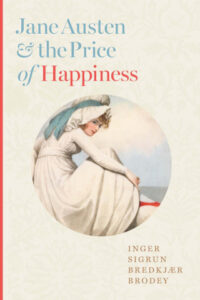
Was Jane Austen Actually the Ultimate Anti-Romantic Novelist?
Inger Sigrun Bredkjær Brodey on How Austen’s Rushed Endings Undercut Her Reputation For Romance
The popular culture surrounding Jane Austen identifies her romantic happy endings as the key feature of her work, as John Atkinson parodies in figure 4 (below). And yet there has been a schism in the reading of those endings. Often the “Cozy Camp” of Austen reception has little to do with the novels themselves, and more to do with the film adaptations and general cultural enthusiasm for Austen. Most adaptations are, in fact, based on fantasy readings of her endings.
But not all readers of Austen are satisfied with Austen’s endings. Some readers and scholars of Austen often complain about the ways Austen complicates, rushes, and destabilizes her endings.
So, what are the characteristics of these endings that have caused Austen “letdown” and have long irritated or disappointed some of her readers? Much of it comes down to expectation: Austen spends her novels building to romantic climaxes that she then suddenly undercuts in the last chapters. For one thing, the speed and pacing of her novels increase notably near the ends: Austen’s conclusions feel rushed, especially in Northanger Abbey, Sense and Sensibility, Mansfield Park, and Emma. This again begs the question: If marriage is so central to Austen as novelist, why does she speed through these resolutions? The pace of her endings is not the only issue that garners frustration. Many other factors contribute to the sense of letdown.
If marriage is so central to Austen as novelist, why does she speed through these resolutions?
Near the end of five of her six major novels, Austen’s narrator remains explicitly and stubbornly silent on the details of the happy unions—using an annoying literary technique called “apophasis,” where the narrator preemptively tells the reader what will not be told. The following passage from the end of Sense and Sensibility represents this effect: “How soon [Edward] had walked himself into the proper resolution, however, how soon an opportunity of exercising it occurred, in what manner he expressed himself, and how he was received, need not be particularly told.” Austen hinders the reader’s luxurious enjoyment of the “proper resolution” by denying us the satisfaction of indulging in the intricate details of the long-awaited denouement.
 Figure 4: Austen spoilers. Comic by John Atkinson. Used with permission of the artist, www.wronghands1.com.
Figure 4: Austen spoilers. Comic by John Atkinson. Used with permission of the artist, www.wronghands1.com.
Austen’s novel Emma provides another famous example of Austen’s cantankerous omissions. At the moment when Emma finally realizes that Mr. Knightley loves her, she wonders how to respond: “She spoke then, on being so entreated.—What did she say?—Just what she ought, of course. A lady always does.—She said enough to shew there need not be despair—and to invite him to say more himself.” Readers at this moment want Emma to drop her affectations and speak from her heart as a woman rather than a “lady,” yet Austen refuses to allow her to do this. She hides Emma’s words at this crucial moment. Emma has never been at a loss for words, so this omission strikes the reader even more forcefully at such a critical juncture. The narrator’s intrusions and pointed omissions deprive the reader of the ability to suspend disbelief, and of the ability to bask fully in the romance of the moment.
Narrators also tend to come out of the shadows and intrude at the end of her novels, rather than disappearing discreetly into the background. Narrators interrupt the denouement with rhetorical questions: “Who can be in doubt of what followed?” (Persuasion) or “With such a confederacy against her,…what could [Marianne] do?” (Sense and Sensibility). In some cases, Austen’s narrator simply drops all pretense and instead speaks as an author, using the first person: “My Fanny indeed at this very time, I have the satisfaction of knowing, must have been happy in spite of everything” (Mansfield Park). Austen’s metafictional flourishes—where she makes us aware that we are reading a novel—also increase as we approach the end of her novels. These features all share one effect: highlighting the fictionality of the novel. They aren’t dissimilar in effect to the sheer speed of resolution and the stubborn silence about romantic details. They seem oddly incongruous with the rest of the novel; they mark a transition to both a new mode and pace of narration; they introduce a new relationship between reader and author.
Austen uses not only speed, apophasis, intrusions, rhetorical questions, and metafictional flourishes, but also plot and coincidence to achieve this sense of the optional, artificial nature of her comic endings. She undercuts romantic happy endings through enforced symmetry of the plot, as in the case of Marianne Dashwood in Sense and Sensibility; through out-of-the-blue deus ex machina resolutions, as in both Northanger Abbey and Emma; and through a forced insistence on hyperbole and “perfection” in her resolutions, especially pronounced in Persuasion.
The poultry thieves in Emma provide a particularly humorous example of deus ex machina: the arrival of a poultry thief into the surrounding area (on the penultimate page of the novel, no less) and his theft of Mrs. Weston’s turkeys frightens Mr. Woodhouse enough to consent to Emma’s marriage and to allow Mr. Knightley to move into Hartfield. In Northanger Abbey, a mysterious viscount suddenly materializes at nearly the same spot in the novel, only a page and a half from the end. This viscount conveniently satisfies General Tilney’s vanity and greed enough to allow Henry to marry Catherine. Are these plot devices signs of lapses in Austen’s invention or artistry? Or do they serve some greater purpose? What should we make of her seeming inconsistency—insisting on slow, organic, probable change throughout each novel, then suddenly resorting to external impetuses, coincidence, and luck for the final resolutions and final marriages to take place?
The complicated and anti-romantic features of Austen’s endings run counter to her reputation as purveyor of delicious rom-com satisfaction.
When you combine the increased pacing, paucity of dialogue, and all these other techniques, the endings feel particularly truncated. Consider that in the last one to three pages of the novels, the following obstacles are removed: Mr. Woodhouse’s objection to marriage, owing to the arrival of poultry thieves (Emma); General Tilney’s objection to Henry’s marriage, owing to the sudden introduction of a titled fiancé for his daughter (Northanger Abbey); expectations that Fanny should marry Henry Crawford, because he has eloped adulterously with Maria (Mansfield Park); Edmund’s infatuation with Mary Crawford, replaced by a sudden realization that he could love Fanny instead (Mansfield Park); and Marianne’s sense that Colonel Brandon is too old and infirm to be a suitable partner in marriage (Sense and Sensibility).
These sudden resolutions feel artificial, gratuitous, and anti-romantic. The repetition of patterns among her novels suggest that she has an overarching purpose in mind. I suggest Austen consciously separates several aspects of her marriage plots’ resolutions for the sake of her didactic purpose. To put it succinctly (and alliteratively), Austen does not want her reader to conflate Romance (the romantic resolution culminating in marriage) with Recognition (the process of individual enlightenment) or with Restoration (the reestablishment of political or social order).
The complicated and anti-romantic features of Austen’s endings run counter to her reputation as purveyor of delicious rom-com satisfaction. She works hard to let us know that things easily could have ended otherwise (that is, unhappily) within the plot of her novels. Attention to these recurring techniques makes us aware of another Jane Austen—one seldom portrayed in popular culture—the Jane Austen who fidgeted, strained, and flinched at the convention of happy endings. The Jane Austen who in fact tried to refuse them to her audience.
__________________________________

Excerpted from Jane Austen and the Price of Happiness by Inger Sigrun Bredkjær Brodey. Copyright © 2024. Published with permission of Johns Hopkins University Press.
Inger Sigrun Bredkjær Brodey
Inger Sigrun Bredkjær Brodey is a professor of English and comparative literature at the University of North Carolina at Chapel Hill. She is the cofounder and director of the Jane Austen Summer Program and Jane Austen & Co., and the principal investigator of Jane Austen’s Desk.



















